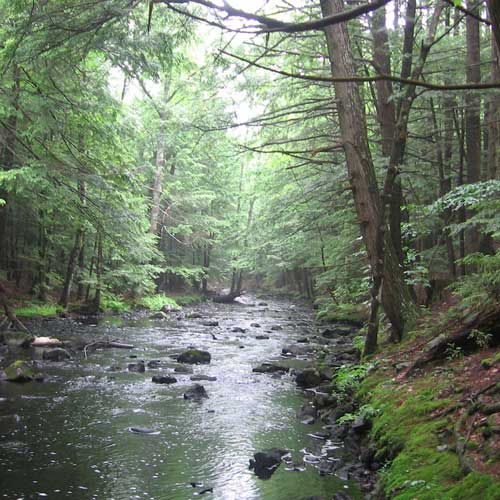The Pawtuckaway River Reservation consists of a series of five individual parcels acquired by the Southeast Land Trust since 2008, including:
- Hauser Tract, acquired in 2009
- Pernokas Tract, acquired in 2008
- Bell Tract, acquired in 2011
- Harbor Street Tract, acquired in 2010
- Bond Tract, acquired in 2008
Why conserve these lands? The Pawtuckaway is one of the Lamprey River’s cleanest tributaries, beginning at Pawtuckaway Lake and connecting with the Lamprey in west Epping. The Pawtuckaway River is located within a core focus area of the Land Conservation Plan for New Hampshire’s Coastal Watershed, a publicly-created blueprint that identified large blocks of land throughout the region as top priorities for land conservation due to water quality, wildlife, and ecological benefits.
There are unsigned trails at this property available to explore!
Adding the Hauser Tract
In September 2009 the Southeast Land Trust added another key piece to its growing Pawtuckaway River Reservation in Epping and Raymond. The acquisition of the 7.2 acre Hauser Tract was the first project in the nation to utilize the Emergency Watershed Program (EWP) funds allocated under the American Recovery and Reinvestment Act and was a partnership between the Land Trust, the Lamprey River Advisory Committee (LRAC) and the Natural Resource Conservation Service (NRCS).

“The protection of the Hauser property is a win-win for everyone and is a great example of how conservation benefits not only the environment, but the surrounding community and our nation,” explains David Viale, Land Protection Specialist. “By conserving this property we are meeting local, regional, and national goals of preserving important natural resources while also providing flood control. In addition, we are helping flood victims voluntarily relocate their home to somewhere that is safe and dry.”
Complementing the acquisition and protection of the land, the Southeast Land Trust worked with the NRCS and wetland scientist Mark West of West Environmental to implement a restoration plan that will restore the habitat and hydrology of the floodplain to a more natural state. A major component of the restoration plan was the removal of a home which was subject to major flooding. To accomplish this, the Land Trust hired Danley Demolition to remove the home and recycle as much of the construction material as possible.
In addition to demolishing the above ground structure, the foundation was removed to allow the river channel to naturally meander over time. After the home and foundation were removed, the area was smoothed over and stabilized with a native plant conservation seed mix. Over the winter, the land trust will be planning the second phase of the restoration, which will involve stabilization of a canoe access area, and restoration of several stream channels.
About the Bell Tract
Acquired in the spring of 2011, the Bell Tract is our newest addition to the growing Pawtuckaway River Reservation, a corridor of forestland along the Pawtuckaway River in Epping and Raymond.
The conservation of the Bell Tract was also long a goal of the owner Virginia Bell, who unfortunately passed away in October 2010 prior to the successful protection of her much-loved land. Ginia, as she was known, called her property Wintergreen Woods and even hand drew an accurate topographic map when she first bought the property in 1980, showing the wetlands, beaver flows, and trails.
“Ginia loved the land,” explains her niece Beth Hostetter. “She knew every inch….each rock, tree, where and when the wintergreen came up, what route the wild turkeys would take, how many beavers there were. Ginia was excited to be part of the Southeast Land Trust and her family is proud to be a small part in honoring her wishes to protect her land.”
Now, as part of the Land Trust’s larger Pawtuckaway River Reservation, the Bell Tract will now be managed and stewarded for wildlife habitat, water quality, and public outdoor recreation.
The Pawtuckaway is one of the Lamprey River’s cleanest tributaries, beginning at Pawtuckaway Lake and connecting with the Lamprey in west Epping. The Pawtuckaway River is located within a core focus area of the Land Conservation Plan for New Hampshire’s Coastal Watershed, a publicly-created blueprint that identified large blocks of land throughout the region as top priorities for land conservation due to water quality, wildlife, and ecological benefits.
Land Conservation Resources
The booklet, Conserving Your Land: Options for New Hampshire Landowners, is a concise and clear guide to possible conservation outcomes for your land. You can request a free copy from SELT, read the booklet online, or download a copy.
Want to Learn More?
If you are considering the conservation of your land, we recommend contacting us to set up a confidential meeting. We will be more than happy to meet with you to discuss your goals, walk your property, and answer your questions. Please contact us.
